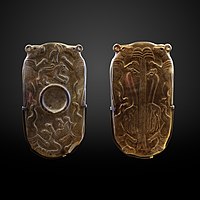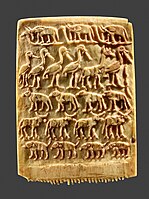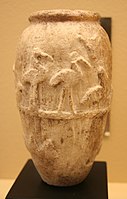  | |
| Geographical range | Egypt |
|---|---|
| Period | Early Bronze I |
| Dates | c. 3,300 BC – 2,900 BC |
| Major sites | Naqada, Tarkhan, Nekhen |
| Preceded by | Naqada II, Maadi culture |
| Followed by | First Dynasty of Egypt |

Naqada III is the last phase of the Naqada culture of ancient Egyptian prehistory, dating from approximately 3200 to 3000 BC. It is the period during which the process of state formation, which began in Naqada II, became highly visible, with named kings heading powerful polities. Naqada III is often referred to as Dynasty 0 or the Protodynastic Period to reflect the presence of kings at the head of influential states, although, in fact, the kings involved would not have been a part of a dynasty. In this period, those kings' names were inscribed in the form of serekhs on a variety of surfaces including pottery and tombs.
History
The Protodynastic Period in ancient Egypt was characterised by an ongoing process of political unification, culminating in the formation of a single state to begin the Early Dynastic Period. Furthermore, it is during this time that the Egyptian language was first recorded in hieroglyphs. There is also strong archaeological evidence of Egyptian settlements in southern Canaan during the Protodynastic Period, which are regarded as colonies or trading entrepôts.
State formation began during this era and perhaps even earlier. Various small city-states arose along the Nile. Centuries of conquest then reduced Upper Egypt to three major states: Thinis, Naqada, and Nekhen. Sandwiched between Thinis and Nekhen, Naqada was the first to fall. Thinis then conquered Lower Egypt. Nekhen's relationship with Thinis is uncertain, but these two states may have merged peacefully, with the Thinite royal family ruling all of Egypt. The Thinite kings were buried at Abydos in the Umm el-Qa'ab cemetery.
Early Egyptologists such as Flinders Petrie were proponents of the Dynastic race theory which hypothesised that the first Egyptian chieftains and rulers were themselves of Mesopotamian origin, but this view has been abandoned among modern scholars.
Most Egyptologists consider Narmer to be both the last king of this period and the first king of the First Dynasty. He was possibly preceded over some parts of Upper Egypt by Crocodile, Iry-Hor, Ka, and perhaps by the king Scorpion II, whose name may refer to, or be derived from, the goddess Serket, a special early protector of other deities and the rulers.
Naqada III extended all over Egypt and was characterized by some notable firsts:
- The first hieroglyphs
- The first graphical narratives on palettes
- The first regular use of serekhs
- Possibly the first example of irrigation
And at best, a notable second:
- The invention of sail navigation (derived from its prior invention in the Persian Gulf 2,000 years earlier)
According to the Egypt's Ministry of Antiquities, in February, 2020, Egyptian archaeologists have uncovered 83 tombs dating back to 3,000 B.C, known as the Naqada III period. Various small ceramic pots in different shapes and some sea shells, makeup tools, eyeliner pots, and jewels were also revealed in the burial.
Decorative cosmetic palettes
Main article: Cosmetic paletteMany notable decorative palettes are dated to Naqada III, such as the Hunters Palette.
-
 Hunters Palette, circa 3100 BC
Hunters Palette, circa 3100 BC
-
 "Four Dogs Palette" (3300–3100 BC)
"Four Dogs Palette" (3300–3100 BC)
-
 Fragment of a ceremonial palette illustrating a man and a type of staff, ca. 3200–3100 BC
Fragment of a ceremonial palette illustrating a man and a type of staff, ca. 3200–3100 BC
-
 Duck-shaped palette
Duck-shaped palette
-
 Bull Palette, 3100 BC
Bull Palette, 3100 BC
-
 The Battlefield Palette, possibly showing the subjection of the people of the Buto-Maadi culture, by the Egyptian rulers of Naqada III, circa 3100 BC.
The Battlefield Palette, possibly showing the subjection of the people of the Buto-Maadi culture, by the Egyptian rulers of Naqada III, circa 3100 BC.
-
 Fragment of a palette, 3200–2800 BC.
Fragment of a palette, 3200–2800 BC.
Other artifacts
-
 Baboon Divinity bearing name of Pharaoh Narmer on base
Baboon Divinity bearing name of Pharaoh Narmer on base
-
 The Scorpion Macehead, Ashmolean Museum.
The Scorpion Macehead, Ashmolean Museum.
-
 Protodynastic sceptre fragment with royal couple. Staatliche Sammlung für Ägyptische Kunst, Munich
Protodynastic sceptre fragment with royal couple. Staatliche Sammlung für Ägyptische Kunst, Munich
-
 Hair Comb Decorated with Rows of Wild Animals 3200–3100 BCE, Naqada III
Hair Comb Decorated with Rows of Wild Animals 3200–3100 BCE, Naqada III
-
 Naqada III vessel
Naqada III vessel
-
 Typical Naqada III cylindrical jar
Typical Naqada III cylindrical jar
See also
- Badarian culture
- Early Dynastic Egypt
- First Dynasty of Egypt
- List of Pharaohs
- Naqada culture
- Scorpion II
- Scorpion Macehead
References
- Hendrickx, Stan (1996). Spencer, A.J. (ed.). "The relative chronology of the Naqada culture: Problems and possibilities". Aspects of Early Egypt. London: British Museum Press: 64.
- ^ Shaw 2000, p. 479.
- Derry, D.E. (1956). "The Dynastic Race in Egypt". Journal of Egyptian Archaeology. 42: 80–85. doi:10.1177/030751335604200111. S2CID 194596267.
- Wilkinson, Toby (1999). Early dynastic Egypt. London: Routledge. p. 15. ISBN 0415186331.
- Yurco, Frank (1996). "An Egyptological Review". (1996). Black Athena revisited. Chapel Hill: University of North Carolina Press. pp. 62–100. ISBN 0807845558.
{{cite book}}: CS1 maint: numeric names: authors list (link) - Zakrzewski, Sonia R. (2007). Population continuity or population change: Formation of the ancient Egyptian state. Highfield, Southampton: Department of Archaeology, University of Southampton.
- *Pg33-"Early Nile Valley populations were primarily coextensive with indigenous African populations. Linguistic and archaeological data provide key supporting evidence for a primarily African origin".Shomarka Keita and A.J. Boyce "The Geographic and Origins and Population Relationships of Early Ancient Egyptians". Celenko Theodore (ed). (1996). Egypt in Africa. Indianapolis, Ind.: Indianapolis Museum of Art. pp. 20–33. ISBN 0936260645.
- *Pg84-85 "major burial sites of those founding locales of ancient Egypt in the fourth millennium BCE, notably El-Badari as well as Naqada, show no demographic indebtedness to the Levant. They reveal instead a population with cranial and dental features with closest parallels to those of other longtime populations of the surrounding areas of northeastern Africa, such as Nubia and the northern Horn of Africa".Ehret, Christopher (20 June 2023). Ancient Africa: A Global History, to 300 CE. Princeton: Princeton University Press. pp. 83–86, 167–169. ISBN 978-0-691-24409-9.
- Shaw 2000, p. 71.
- Meza, A.I. (2007) “Neolithic Boats: Ancient Egypt and the Maltese Islands. A Minoan Connection” J-C. Goyon,C. Cardin (Eds.) Actes Du Neuvième Congrès International Des Égyptologues, p. 1287.
- Robinson, D. (2012). "Review of: Anderson, A., et al. (2010), The Global Origins and Development of Seafaring". International Journal of Nautical Archaeology. 41 (1): 206–208. doi:10.1111/j.1095-9270.2011.00333_2.x. S2CID 162515460.
- Geggel, Laura (21 February 2020). "Dozens of ancient Egyptian graves found with rare clay coffins". livescience.com. Retrieved 2020-06-28.
- "الكشف عن 83 مقبرة أثرية بمنطقة آثار كوم الخلجان بمحافظة الدقهلية". اليوم السابع. 2020-02-12. Retrieved 2020-06-28.
- Brovarski, Edward. "REFLECTIONS ON THE BATTLEFIELD AND LIBYAN BOOTY PALETTES": 89.
{{cite journal}}: Cite journal requires|journal=(help)
Further reading
- Anđelković, Branislav (2002). "Southern Canaan as an Egyptian Protodynastic Colony". Cahiers Caribéens d'Égyptologie. 3/4 (Dix ans de hiéroglyphes au campus): 75–92.
- Bard, Katherine A. (2000). "The Emergence of the Egyptian State". In Shaw, Ian (ed.). The Oxford History of Ancient Egypt. Oxford and New York: Oxford University Press. pp. 61–88. ISBN 0-19-815034-2.
- Midant-Reynes, Béatrix (2000). The Prehistory of Egypt: From the First Egyptians to the First Pharaohs. Oxford and Malden: Blackwell. ISBN 0-631-20169-6.
- Shaw, Ian, ed. (2000). The Oxford History of Ancient Egypt. Oxford University Press. ISBN 0-19-815034-2.
- Wilkinson, Toby Alexander Howard (2001). Early Dynastic Egypt (2nd ed.). London: Routledge. ISBN 0-415-18633-1.
- Wright, Mary (1985). "Contacts Between Egypt and Syro-Palestine During the Protodynastic Period". Biblical Archaeologist. 48 (4): 240–53. doi:10.2307/3209960. JSTOR 3209960. S2CID 165458408.
External links
- Naqada III: Dynasty 0
- "Unification Theories", Naqadan in Egypt, UK: UCL.
| Rulers of the ancient Near East | ||||||||||||||||||||||||||||||||||||||||||||||||||||||||||||||||||||||||||||||||||||||||||||||||||||||||||||||||||||||||||||||||||||||||||||||||||||||||||||||||||||||||||||||||||||||||||||||||||||||||||||||||||||||||||||||||||||||||||||||||||||||||||||||||||||||||||||||||||||||||||||||||||||||||||||||||||||||||||||||||||||||||||||||||||||||||||||||||||||||||||||||||||||||||||||||||||||||||||||||||||||||||||||||||||||||||||||||||||||||||||||||||||||||||||||||||||||||||||||||||||||||||||||||||||||||||||||||||||||||||||||||||||||||||||||||||||||||||||||||||||||||||||||||||||||||||||||||||||||||||||||||||||||||||||||||||||||||||||||||||||||||||||||||||||
|---|---|---|---|---|---|---|---|---|---|---|---|---|---|---|---|---|---|---|---|---|---|---|---|---|---|---|---|---|---|---|---|---|---|---|---|---|---|---|---|---|---|---|---|---|---|---|---|---|---|---|---|---|---|---|---|---|---|---|---|---|---|---|---|---|---|---|---|---|---|---|---|---|---|---|---|---|---|---|---|---|---|---|---|---|---|---|---|---|---|---|---|---|---|---|---|---|---|---|---|---|---|---|---|---|---|---|---|---|---|---|---|---|---|---|---|---|---|---|---|---|---|---|---|---|---|---|---|---|---|---|---|---|---|---|---|---|---|---|---|---|---|---|---|---|---|---|---|---|---|---|---|---|---|---|---|---|---|---|---|---|---|---|---|---|---|---|---|---|---|---|---|---|---|---|---|---|---|---|---|---|---|---|---|---|---|---|---|---|---|---|---|---|---|---|---|---|---|---|---|---|---|---|---|---|---|---|---|---|---|---|---|---|---|---|---|---|---|---|---|---|---|---|---|---|---|---|---|---|---|---|---|---|---|---|---|---|---|---|---|---|---|---|---|---|---|---|---|---|---|---|---|---|---|---|---|---|---|---|---|---|---|---|---|---|---|---|---|---|---|---|---|---|---|---|---|---|---|---|---|---|---|---|---|---|---|---|---|---|---|---|---|---|---|---|---|---|---|---|---|---|---|---|---|---|---|---|---|---|---|---|---|---|---|---|---|---|---|---|---|---|---|---|---|---|---|---|---|---|---|---|---|---|---|---|---|---|---|---|---|---|---|---|---|---|---|---|---|---|---|---|---|---|---|---|---|---|---|---|---|---|---|---|---|---|---|---|---|---|---|---|---|---|---|---|---|---|---|---|---|---|---|---|---|---|---|---|---|---|---|---|---|---|---|---|---|---|---|---|---|---|---|---|---|---|---|---|---|---|---|---|---|---|---|---|---|---|---|---|---|---|---|---|---|---|---|---|---|---|---|---|---|---|---|---|---|---|---|---|---|---|---|---|---|---|---|---|---|---|---|---|---|---|---|---|---|---|---|---|---|---|---|---|---|---|---|---|---|---|---|---|---|---|---|---|---|---|---|---|---|---|---|---|---|---|---|---|---|---|---|---|---|---|---|---|---|---|---|---|---|---|---|---|---|---|---|---|---|---|---|---|---|---|---|---|---|---|---|---|---|---|---|---|---|---|---|---|---|---|---|---|---|---|---|---|---|---|---|---|---|---|---|---|---|---|---|---|---|---|---|---|---|---|---|---|---|---|---|---|---|---|---|---|---|---|---|---|---|---|---|---|---|---|---|---|---|---|---|---|---|---|---|---|---|---|---|---|---|---|---|---|---|---|---|---|---|---|---|---|---|---|---|---|---|---|---|---|---|---|---|---|---|---|---|---|---|---|---|---|---|---|---|---|---|---|---|---|---|---|---|---|---|---|---|---|---|---|---|---|---|---|---|---|---|---|---|---|---|---|---|---|---|---|---|---|---|---|---|---|
| ||||||||||||||||||||||||||||||||||||||||||||||||||||||||||||||||||||||||||||||||||||||||||||||||||||||||||||||||||||||||||||||||||||||||||||||||||||||||||||||||||||||||||||||||||||||||||||||||||||||||||||||||||||||||||||||||||||||||||||||||||||||||||||||||||||||||||||||||||||||||||||||||||||||||||||||||||||||||||||||||||||||||||||||||||||||||||||||||||||||||||||||||||||||||||||||||||||||||||||||||||||||||||||||||||||||||||||||||||||||||||||||||||||||||||||||||||||||||||||||||||||||||||||||||||||||||||||||||||||||||||||||||||||||||||||||||||||||||||||||||||||||||||||||||||||||||||||||||||||||||||||||||||||||||||||||||||||||||||||||||||||||||||||||||||












